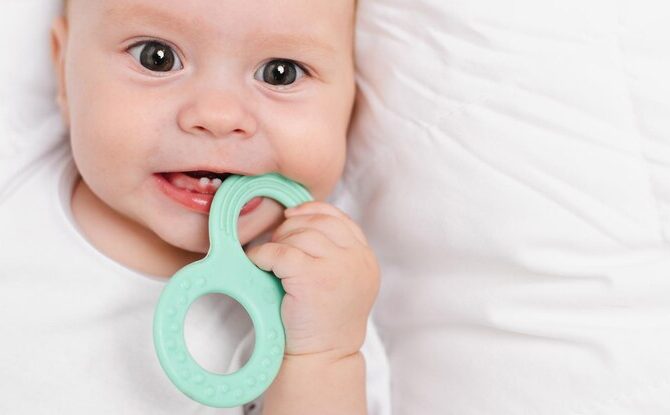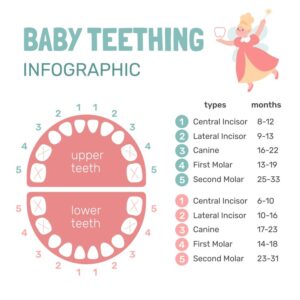
What are the Stages of Teething for Babies?
The teething process is an important developmental milestone in a baby’s life. Parents often ask how to expect the phases of teething when their child’s first set of teeth emerges. Listed below are the stages of teething for babies, as well as the warning signs and symptoms, as well as advice on how to relieve discomfort.

Eruption of the First Teeth
Although it might vary from newborn to baby, teething usually starts between 4 and 7 months. It is often the lower front teeth, commonly referred to as the central incisors, that first erupt. This period may be unnoticeable for many infants, but it may occasionally cause some discomfort.
Eruption of the Incisors
During the second teething stage, the upper central incisors emerge, followed by the lower lateral incisors on both the upper and lower jaws. These teeth erupt next to the central incisors. Babies may drool more, have swollen gums, and be mildly irritable. They might also need to chew or bite to relieve their agony.
The appearance of the First Molars
As a child ages 12 to 16 months, the first molars begin to erupt at the back of the mouth. A person with more prominent, flatter teeth might experience increased irritation, disturbed sleep patterns, and a tendency to put things in their mouth to soothe sore gums, among other symptoms. It is possible that the eruption of the molars will be delayed, accompanied by gum sensitivity and moderate irritation.
The arrival of the canine teeth
Cuspids, also known as canines or eye teeth, usually emerge between 16 and 20 months of age. They are close to the lateral incisors. Symptoms of canine eruption include increased sensitivity, drooling, aching gums, and a desire to chew. A short-term change in a baby’s feeding or sleeping schedule could result.
The Appearance of the Second Molars
A child’s teething process ends when the second molars begin to emerge between 20 and 30 months old. These molars are located behind the first molars in the rear of the mouth. As with the first molars, second molar development can cause sore gums, heightened irritability, and an urge to chew on things similar to those of the first molars.
Tips to Ease Teething Discomfort
- Use a moist towel or clean finger to gently massage the baby’s gums.
- Providing the infant with short-term respite is as simple as giving an infant a chilled teething ring or a fresh, cold washcloth.
- Make sure your baby has secure, BPA-free teething toys that they can bite to relieve sore gums.
- Consult a pediatric dentist about the proper dose of over-the-counter painkillers or teething gels.
- To assist in calming the infant through this unpleasant stage, give more love, attention, and comfort.
Parents can more confidently manage this normal developmental process by being aware of the teething phases in newborns. There are different difficulties at each stage.
If you are a parent struggling to manage your baby’s teething process or have queries regarding their challenges, specialist pediatric dentist Dubai at All Smiles Dental Spa can help you identify the symptoms and provide appropriate guidance.
Leave a reply

Leave a reply